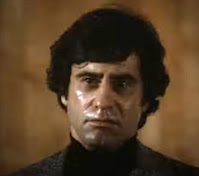Father Kevin (James Farentino, at right) is an alcoholic priest who is beginning to show signs of his struggles even when holding mass. While impaired, he crashes his car and dies, but is brought back to life by a supernatural force that tells him he can redeem himself by seeking out and fighting evil. Meanwhile, at the Helen Page School for Girls in Salem, Oregon, strange incidents of what seem to be spontaneous combustion are occurring regularly: a dorm room is burnt up, a piece of paper in a typewriter catches on fire. The headmistress Louise (Joan Hackett) is dealing with stress from financial problems. Her stepsister Ellen (Claudette Nevins) is a teacher whose daughter Weezie is enrolled at the school and is often on the brink of getting into trouble, even having a secret fling with Paul, an instructor (Harrison Ford), who also flirts with Louise. When one student's legs are burnt badly while she's giving a speech, the cops get involved as does Father Kevin—it's never explained whether he's flesh and blood, or a supernatural being, or even what he does for a living anymore, though he suspects that a possession is happening and an exorcism may be in order.
This was made a few years after The Exorcist when possession movies were the rage, but it was made for television so the gore and horror had to be toned down. The various occurrences of fire are mostly as explicit as things get, but the fire effects are well done, especially one near the end involving a swimming pool in flames. Though the ending leaves things with the priest's character vague—he basically just vanishes—this has the feel of a TV pilot in which Father Kevin would have solved a possession case each week. Farentino, darkly but quirkily handsome, underplays his role (some call him wooden, but I prefer taciturn) and still manages to seem fairly charismatic. Hackett and Nevins look enough alike that I was getting them mixed up for the first half-hour of the movie. It’s fun to see Harrison Ford, weeks before the release of Star Wars would change his life, playing a role not dissimilar from Indiana Jones. I suspect his character is supposed to be a bit slimy and unsympathetic, but his youthful charm comes through to add a bit of complexity to the part. Diana Scarwid (the older Christina in Mommie Dearest) and Ann Dusenberry are quite good as two of the students. Eugene Roche is the cop. Not necessarily one to hunt down but a solid example of the 70s made-for-TV horror film. [YouTube]













